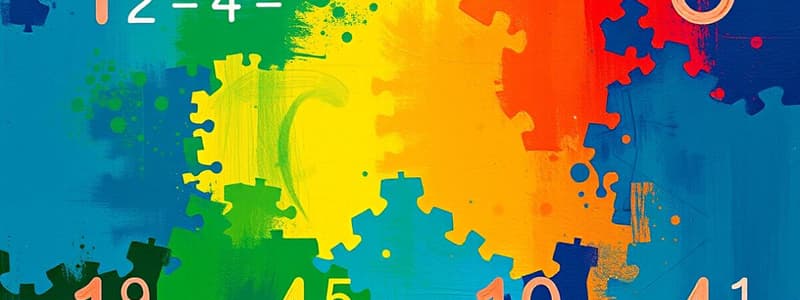Podcast
Questions and Answers
Which statement is true regarding the properties of multiplication as observed in multiplication tables?
Which statement is true regarding the properties of multiplication as observed in multiplication tables?
- The product of two numbers is always less than the larger number.
- Multiplication by zero results in doubling the other number.
- Multiplying by two always produces an odd number.
- Multiplying by one yields the same number as the other number. (correct)
What is a common pattern found in the multiples of 5 in a multiplication table?
What is a common pattern found in the multiples of 5 in a multiplication table?
- The products alternate between odd and even numbers.
- The products always end with a 2 or 4.
- The products always end with 0 or 5. (correct)
- The products always increase by 3.
What is an effective strategy for mastering multiplication tables?
What is an effective strategy for mastering multiplication tables?
- Only practicing larger numbers to build confidence.
- Focusing solely on memorizing the entire table at once.
- Avoiding repetition to keep learning fresh.
- Using visual aids and real-life examples to enhance understanding. (correct)
How does symmetry in multiplication tables help students?
How does symmetry in multiplication tables help students?
Why are multiplication tables essential for understanding advanced math concepts?
Why are multiplication tables essential for understanding advanced math concepts?
Flashcards are hidden until you start studying
Study Notes
Multiplication Tables
-
Definition: A multiplication table is a structured chart that displays the results of multiplying numbers together.
-
Basic Structure:
- Typically organized in a grid format.
- Rows and columns represent the numbers being multiplied.
- The cell at the intersection shows the product of the corresponding row and column numbers.
-
Common Multiplication Tables:
- 1 to 10 Table: Most basic multiplication table, covering products of integers from 1 to 10.
- 1 to 12 Table: Frequently used in schools; extends the basic table for more comprehensive practice.
-
Patterns:
- Multiplying by 1: The product is the same as the other number (e.g., 1 × n = n).
- Multiplying by 0: The product is always 0 (e.g., 0 × n = 0).
- Multiples of 5: Ends with 0 or 5.
- Multiples of 2: All even numbers.
- Symmetry: The table is symmetrical; for example, 3 × 4 = 4 × 3.
-
Use in Learning:
- Essential for developing arithmetic skills.
- Helps with understanding more advanced math concepts, such as division and fractions.
- Reinforces the concept of repeated addition.
-
Strategies for Memorization:
- Repetition: Practice regularly to enhance memory.
- Patterns: Identify and learn patterns within the table.
- Games and apps: Utilize educational tools to make learning interactive.
-
Applications:
- Fundamental in various fields, including science, engineering, and finance.
- Provides a basis for solving real-world problems involving calculations.
-
Tips for Mastery:
- Start with smaller numbers and gradually increase complexity.
- Use visual aids, such as colorful charts or flashcards.
- Encourage the use of real-life examples to apply multiplication skills.
Definition and Structure
- A multiplication table is a systematic chart showing the results of multiplying numbers.
- Organized in a grid format with rows and columns representing the numbers multiplied.
- The product of the corresponding row and column is displayed in the intersecting cell.
Common Multiplication Tables
- 1 to 10 Table: Basic multiplication covering integers from 1 to 10.
- 1 to 12 Table: Commonly used in educational settings, providing extended practice.
Notable Patterns
- Multiplying by 1: The product remains unchanged (e.g., 1 × n = n).
- Multiplying by 0: Always results in zero (e.g., 0 × n = 0).
- Multiples of 5: Products end with either 0 or 5.
- Multiples of 2: All products are even numbers.
- Symmetrical Property: The table exhibits symmetry, such as 3 × 4 being equal to 4 × 3.
Use in Learning
- Fundamental for nurturing arithmetic abilities.
- Aids comprehension of advanced math concepts like division and fractions.
- Demonstrates the principle of repeated addition.
Memorization Strategies
- Repetition: Regular practice enhances retention of multiplication facts.
- Identifying Patterns: Learning number patterns boosts recall and understanding.
- Educational Tools: Use games and apps for a fun and interactive learning experience.
Applications
- Crucial across various disciplines, including science, engineering, and finance.
- Serves as a foundation for solving practical problems requiring calculations.
Tips for Mastery
- Begin with simpler numbers before progressing to more complex ones.
- Implement visual aids, such as colorful charts or flashcards, to facilitate learning.
- Relate multiplication skills to real-life scenarios for better understanding and application.
Studying That Suits You
Use AI to generate personalized quizzes and flashcards to suit your learning preferences.



